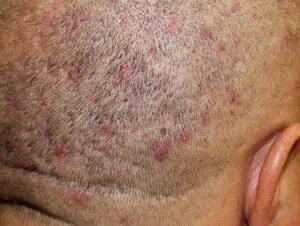What Is Fungal Acne and How Do You Get Rid of It?

Medically reviewed by Danica Alexander, DO
Have itchy acne? If pimple-fighting products do nothing to tame it—or even make it worse—it may be because you don’t have true acne at all but something entirely different. One possibility is fungal acne, also called Malassezia folliculitis or Pityrosporum folliculitis. It can look so much like acne that it’s often misdiagnosed. If you’ve been battling small red bumps on your skin for months or even years with no success, read on to learn if fungal acne could be the real cause and if so, how to treat it.
What is fungal acne?
Technically, fungal acne isn’t acne. Acne vulgaris is caused by clogged pores and bacteria. Fungal acne is caused by an overgrowth of a yeast (a type of fungus) that lives on the skin. When this yeast, called Malassezia, invades the hair follicles, clusters of small red bumps can develop. Something these “fungal pimples” fill with yellow or white pus. Itching is a common fungal acne symptom, occurring in about 80% of cases.
Fungal acne on the face may appear on the forehead, cheeks or elsewhere. Fungal acne on the forehead looks like forehead bumps that may line up in rows. The infection can also be seen on the chest, back and arms.
Bacterial acne vs. fungal acne
Fungal acne and acne vulgaris can look alike, so it’s not uncommon to think you have true acne when fungus is to blame. (To complicate matters, some people have both.) But there are a few telltale differences. A Malassezia infection is much more likely to itch. The bumps are smaller and more uniform in size, and they tend to appear in clusters.
If you have another skin condition caused by an overgrowth of yeast, such as seborrheic dermatitis (dandruff), you’re more likely to have fungal acne.
Who gets it?
Anyone can develop this type of acne, but it’s more common in teenagers and young men. Other risk factors include:
- Having oily skin
- Sweating a lot or living in a hot, humid environment
- Wearing tight clothing or clothing that doesn’t breathe
- Re-wearing sweaty clothes or staying in them too long
- Wearing heavy makeup
- Taking certain medications, such as oral contraceptives, antibiotics, oral steroids and immunosuppressive drugs
- Having a disease such as diabetes, leukemia or lymphoma that increases the risk of yeast overgrowth
How to get rid of fungal acne
A dermatologist can determine whether you have acne and which type. Getting an accurate diagnosis is critical before starting fungal acne treatment.
Your dermatologist may recommend an over-the-counter topical antifungal medication or prescribe a stronger version. If it doesn’t do the trick, you may need a prescription oral antifungal. These folliculitis medications sometimes work better than topical products, and they work fast, but they can cause side effects such as stomach pain and diarrhea.
If antifungal medication can’t cure your Malassezia folliculitis, your dermatologist might recommend photodynamic therapy. It uses light energy in combination with a drug activated by light to kill the fungus.
Paying close attention to your hygiene is an essential part of treating and preventing a Malassezia overgrowth. Shower regularly, especially after you’ve been sweating, and wear loose, breathable clothing. Don’t use oily creams. If you’ve had more than one bout of fungal acne, try washing the affected area(s) with anti-dandruff shampoo.
Written by Jessica Brown, a health and science writer/editor based in Nanuet, New York. She has written for Prevention magazine, jnj.com, BCRF.org, and many other outlets.

